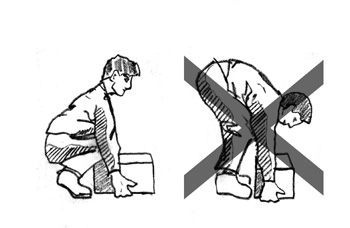 Improper lifting technique can lead to back, leg and arm pain. Poor technique can cause both acute injury, and serious chronic effects. Learning the right way to lift will help you avoid these problems.
Improper lifting technique can lead to back, leg and arm pain. Poor technique can cause both acute injury, and serious chronic effects. Learning the right way to lift will help you avoid these problems. Here's How:
- Plan ahead before lifting.
Knowing what you're doing and where you're going will prevent you from making awkward movements while holding something heavy. Clear a path, and if lifting something with another person, make sure both of you agree on the plan. - Lift close to your body.
You will be a stronger, and more stable lifter if the object is held close to your body rather than at the end of your reach. Make sure you have a firm hold on the object you are lifting, and keep it balanced close to your body. - Feet shoulder width apart.
A solid base of support is important while lifting. Holding your feet too close together will be unstable, too far apart will hinder movement. Keep the feet about shoulder width apart and take short steps. - Bend your knees and keep your back straight.
Practice the lifting motion before you lift the object, and think about your motion before you lift. Focus on keeping you spine straight--raise and lower to the ground by bending your knees. - Tighten your stomach muscles.
Tightening your abdominal muscles will hold your back in a good lifting position and will help prevent excessive force on the spine. - Lift with your legs.
Your legs are many times stronger than your back muscles--let your strength work in your favor. Again, lower to the ground by bending your knees, not your back. Keeping your eyes focused upwards helps to keep your back straight. - If you're straining, get help.
If an object is too heavy, or awkward in shape, make sure you have someone around who can help you lift. - Wear a belt or back support.
If you are lifting in your job or often at home a back belt can help you maintain a better lifting posture.
Tips:
- Never bend your back to pick something up.
It's just not worth the damage that improper lifting technique can cause. - Hold the object close to your body.
You are a much more stable lifter if you're not reaching for an object. - Don't twist or bend.
Face in the direction you are walking. If you need to turn, stop, turn in small steps, and then continue walking. - Keep your eyes up.
Looking slightly upwards will help you maintain a better position of the spine.
Author Jonathan Cluett, M.D., About.com Guide
If you are unlucky to suffer back pain from improper lifting technique,
Treatment
A doctor can advise on the best treatment. Most cases get better in a few weeks.
• It is best to get back to normal activities of daily living as soon as possible. Prolonged bed rest can be harmful. Avoid activities and situations that make back pain worse.
• Heat or cold packs applied to the painful area may bring relief.
• Adopt comfortable positions. Try sleeping on a firm mattress with two pillows under your knees. Keep your back flat.
• Back pain may be relieved by stretching, exercise, massage or manipulation. Ask a physiotherapist or other health care practitioner with expertise in back care.
• After recovery, an exercise program for back and abdominal muscles can help prevent re-injury – ask a health care practitioner with expertise in back care.
• Surgery can help some types of back pain (e.g., sciatica or a damaged disc).
Medicines
Simple oral pain relieving and anti-inflammatory medicines like diclofenac or meloxicam tablets can be recommended by a pharmacist. Topical antiinflammatories like piroxicam gel can also be purchased from the pharmacy.
Stronger pain relieving medicines can be prescribed by a doctor.
Medicines that relax back muscles can be prescribed by a doctor
An injection of corticosteroid or local anaesthetic into a joint or nerve area can sometimes relieve severe back pain.
Self care
To relieve and prevent back pain consider how you are using your back and always try to keep your back straight. Sit, walk and stand with a balanced, relaxed posture. Learn exercises to improve posture and mobility – ask a health care practitioner with expertise in back care.
Stay healthy
• Keep to a healthy body weight.
• Exercise at a moderate level for at least 30 minutes on most or preferably all days of the week.
• Learn and practice regular strengthening and flexibility exercises – ask a health care practitioner with expertise in back care.
• Learn and practice relaxation techniques to reduce muscle tension.
Avoid
• Staying in the same position for long periods, especially sitting. If driving for a long time, take regular breaks to stand, stretch and walk.
• Sudden, forceful movements.
• Coughing or sneezing with your back bent over or twisted.
• Sleeping on your stomach.
• Carrying unbalanced or one-sided loads.
• Depending on pain relieving medicine to relieve persistent pain.
Source: www.nationalpharmacies.com.au
Picture Credit www.mastergardenproducts.com
How to lift a heavy object 23 Jul 2008\ Uploaded by pdhsyu


No comments:
Post a Comment